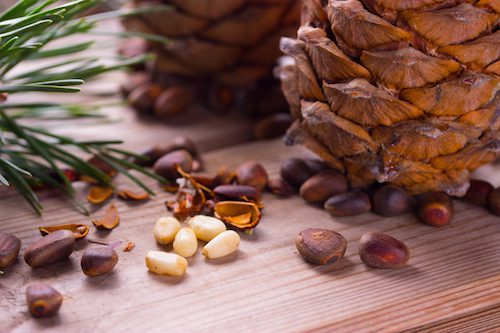How to choose the right pine nut?
Pine nuts are most often sold in the form of kernels, but sometimes the cones themselves appear on the shelves. The second option has more decorative meaning. The kernels tend to fall out during the ripening process, so there may be very few of them in the cone.
Pine nuts can be sold in the following types:
- crude kernels;
- peeled kernels;
- kernels with additional ingredients (pine nuts in glaze, in syrup, in chocolate, etc.)
Buying nuts in cones is not recommended. Unlike the shell, the cone accelerates the process of rotting of the kernels, and it will be impossible to find out their nuances of storage and transportation. The risk of a large number of spoiled nuts in this case is also very high.
How to choose pine nuts
The age of pine nuts is one of the main nuances in assessing their quality. Old kernels not only have impaired taste, but can also be harmful to health when eaten. You can determine the freshness of nuts by their structure, color and smell.
The nuances of choosing high-quality pine nuts:
- the color of the shell and the kernel of the pine nut itself must be uniform (any spots are considered a sign of disease or parasite damage);
- pine nut kernels should not be too dry (otherwise there is a risk of buying stale nuts);
- pine nuts must be the same size;
- if you take a handful of pine nuts, then their weight and relative humidity should be felt well (humidity, as a sign of freshness, should not be confused with the presence of liquid or oil);
- if the tip of the peeled pine nut kernel has darkened, then this is a sign of long-term storage (it is not recommended to buy such nuts);
- a black dot on an unpeeled pine nut, on the contrary, indicates the presence of a kernel inside it (a nut without a dark spot may be empty);
- the aroma of pine nuts should not contain foreign odors;
- the standard size of a pine nut is the area of the nail on the little finger of a woman’s hand;
- if the cedar nut shell is too dark, there is no characteristic stain on it, and there is a slight coating, then such a kernel is spoiled (it will taste bitter, and eating it will harm digestion);
- on the kernels of pine nuts there should be no foreign substances, no plaque, and even more mold (even if the kernels are unpeeled, then the mold affects all their parts, and cleaning will not get rid of bacteria).
If there is a choice between buying peeled pine nuts and unpeeled kernels sold by weight, then it is better to give preference to the second option. Uncoated nuts are stored less and are more susceptible to environmental factors, and especially to the influence of light, sunlight and heat.
When you shouldn’t buy pine nuts:
- if oil has appeared on the surface of pine nuts, then they should not be eaten (light and excessively high air humidity negatively affect the kernels and accelerate the process of oil release, which in turn can harm health when eaten);
- if there is an unpleasant odor from pine nuts (bitterness, dampness, mold), then it is worth giving up their use and purchase;
- you should not buy nuts with obvious signs of disease or insect damage (bacteria are dangerous to health);
- if there is a large amount of garbage in the kernels, then the nuts were collected and stored incorrectly (in addition, garbage accelerates the process of rotting nuts).
If pine nuts are purchased in packages, then in addition to the information provided by the manufacturer and the integrity of the package, its contents must be checked. Kernels must not stick together, be crushed or broken, or contain debris. Pine nuts ripen in the fall, so picking time is September or October. You should not buy kernels in completely transparent packages. Light is harmful to them and the nuts can be spoiled, despite the acceptable appearance.










